Caring for the elderly in community
VerifiedAdded on 2023/01/17
|7
|2148
|47
AI Summary
This article discusses the roles of healthcare assistants in community care provision, the influence of culture and ethnicity on older people, and the services and support available for them. It also provides insights on how older people can prepare for retirement and pursue their interests.
Contribute Materials
Your contribution can guide someone’s learning journey. Share your
documents today.
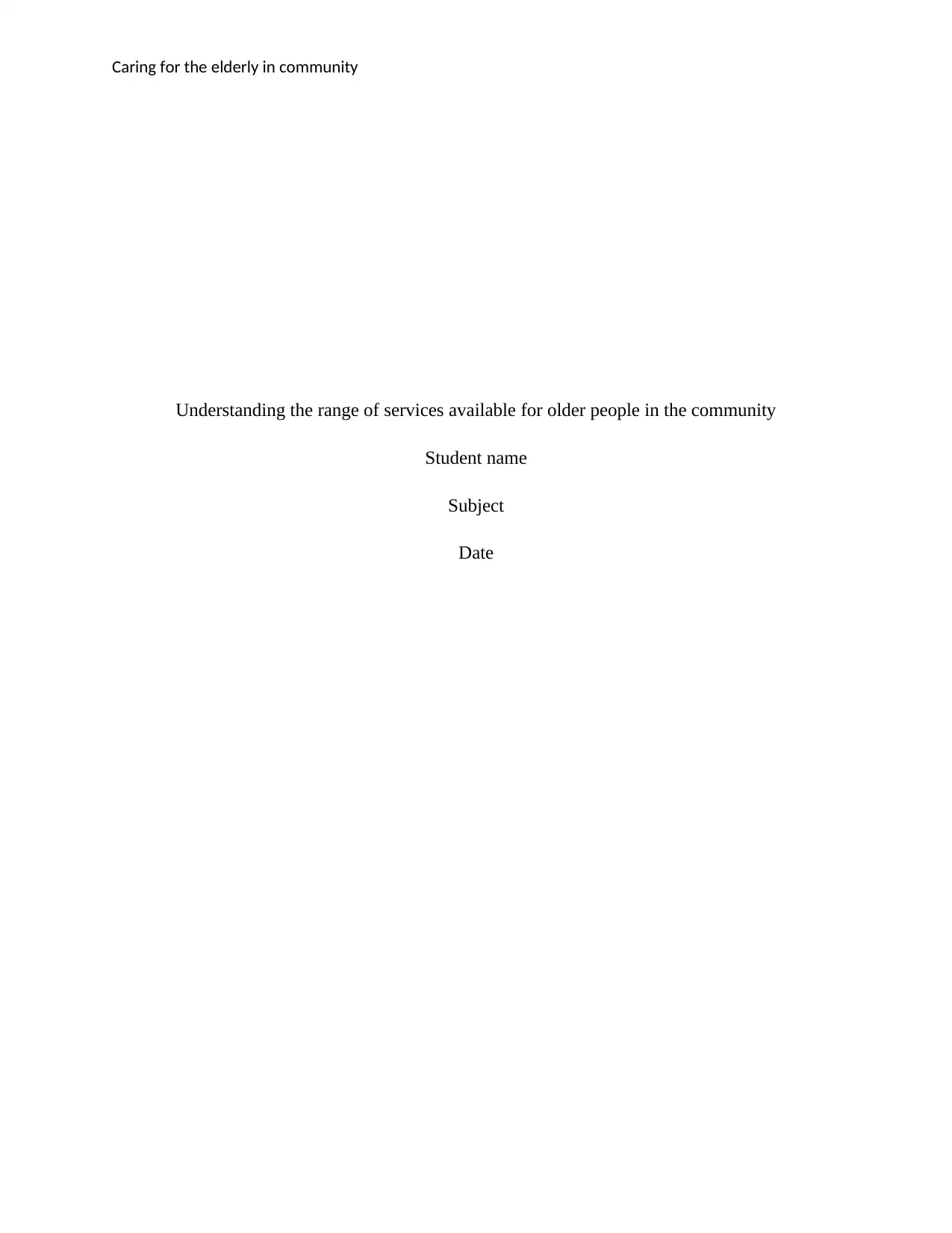
Caring for the elderly in community
Understanding the range of services available for older people in the community
Student name
Subject
Date
Understanding the range of services available for older people in the community
Student name
Subject
Date
Secure Best Marks with AI Grader
Need help grading? Try our AI Grader for instant feedback on your assignments.
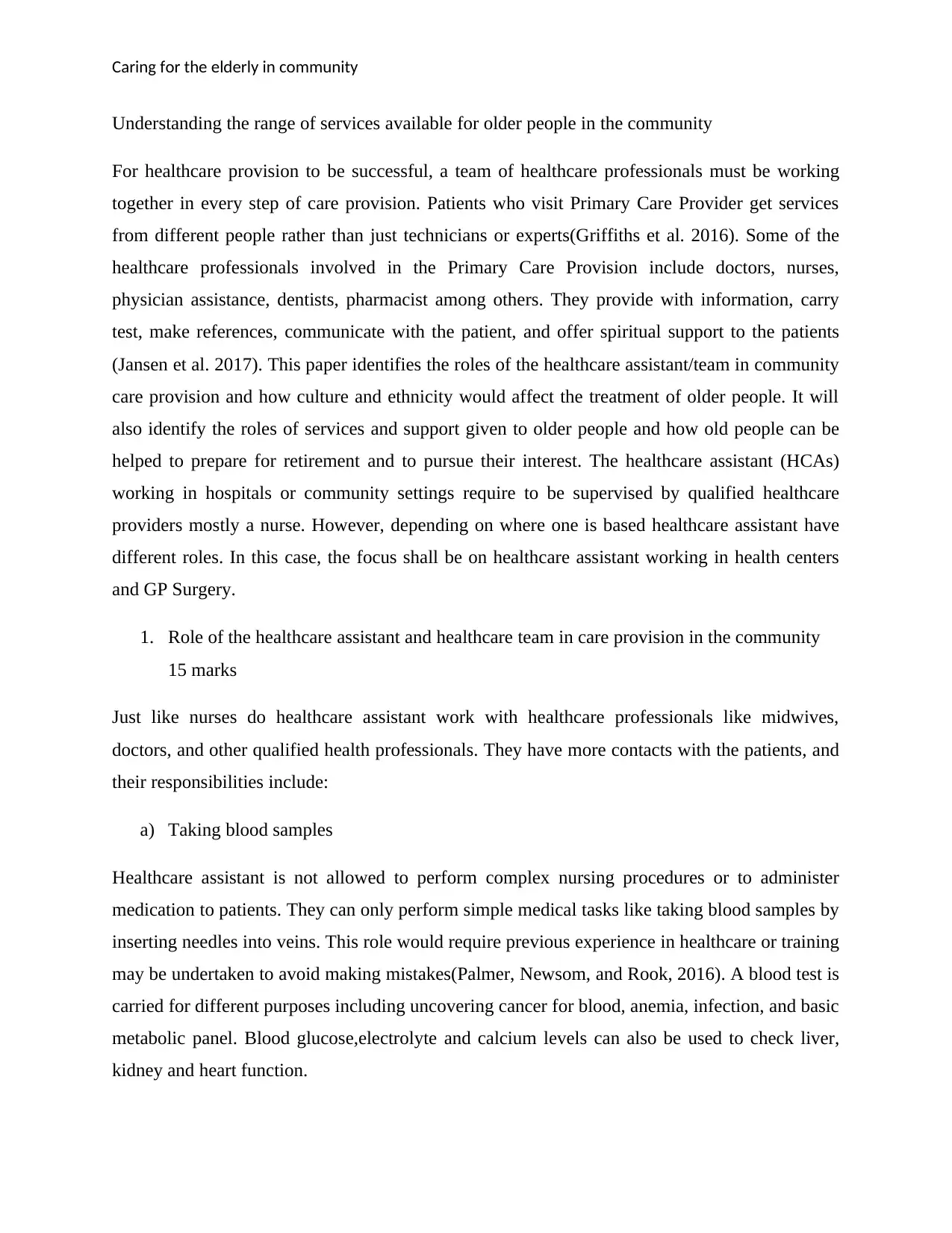
Caring for the elderly in community
Understanding the range of services available for older people in the community
For healthcare provision to be successful, a team of healthcare professionals must be working
together in every step of care provision. Patients who visit Primary Care Provider get services
from different people rather than just technicians or experts(Griffiths et al. 2016). Some of the
healthcare professionals involved in the Primary Care Provision include doctors, nurses,
physician assistance, dentists, pharmacist among others. They provide with information, carry
test, make references, communicate with the patient, and offer spiritual support to the patients
(Jansen et al. 2017). This paper identifies the roles of the healthcare assistant/team in community
care provision and how culture and ethnicity would affect the treatment of older people. It will
also identify the roles of services and support given to older people and how old people can be
helped to prepare for retirement and to pursue their interest. The healthcare assistant (HCAs)
working in hospitals or community settings require to be supervised by qualified healthcare
providers mostly a nurse. However, depending on where one is based healthcare assistant have
different roles. In this case, the focus shall be on healthcare assistant working in health centers
and GP Surgery.
1. Role of the healthcare assistant and healthcare team in care provision in the community
15 marks
Just like nurses do healthcare assistant work with healthcare professionals like midwives,
doctors, and other qualified health professionals. They have more contacts with the patients, and
their responsibilities include:
a) Taking blood samples
Healthcare assistant is not allowed to perform complex nursing procedures or to administer
medication to patients. They can only perform simple medical tasks like taking blood samples by
inserting needles into veins. This role would require previous experience in healthcare or training
may be undertaken to avoid making mistakes(Palmer, Newsom, and Rook, 2016). A blood test is
carried for different purposes including uncovering cancer for blood, anemia, infection, and basic
metabolic panel. Blood glucose,electrolyte and calcium levels can also be used to check liver,
kidney and heart function.
Understanding the range of services available for older people in the community
For healthcare provision to be successful, a team of healthcare professionals must be working
together in every step of care provision. Patients who visit Primary Care Provider get services
from different people rather than just technicians or experts(Griffiths et al. 2016). Some of the
healthcare professionals involved in the Primary Care Provision include doctors, nurses,
physician assistance, dentists, pharmacist among others. They provide with information, carry
test, make references, communicate with the patient, and offer spiritual support to the patients
(Jansen et al. 2017). This paper identifies the roles of the healthcare assistant/team in community
care provision and how culture and ethnicity would affect the treatment of older people. It will
also identify the roles of services and support given to older people and how old people can be
helped to prepare for retirement and to pursue their interest. The healthcare assistant (HCAs)
working in hospitals or community settings require to be supervised by qualified healthcare
providers mostly a nurse. However, depending on where one is based healthcare assistant have
different roles. In this case, the focus shall be on healthcare assistant working in health centers
and GP Surgery.
1. Role of the healthcare assistant and healthcare team in care provision in the community
15 marks
Just like nurses do healthcare assistant work with healthcare professionals like midwives,
doctors, and other qualified health professionals. They have more contacts with the patients, and
their responsibilities include:
a) Taking blood samples
Healthcare assistant is not allowed to perform complex nursing procedures or to administer
medication to patients. They can only perform simple medical tasks like taking blood samples by
inserting needles into veins. This role would require previous experience in healthcare or training
may be undertaken to avoid making mistakes(Palmer, Newsom, and Rook, 2016). A blood test is
carried for different purposes including uncovering cancer for blood, anemia, infection, and basic
metabolic panel. Blood glucose,electrolyte and calcium levels can also be used to check liver,
kidney and heart function.
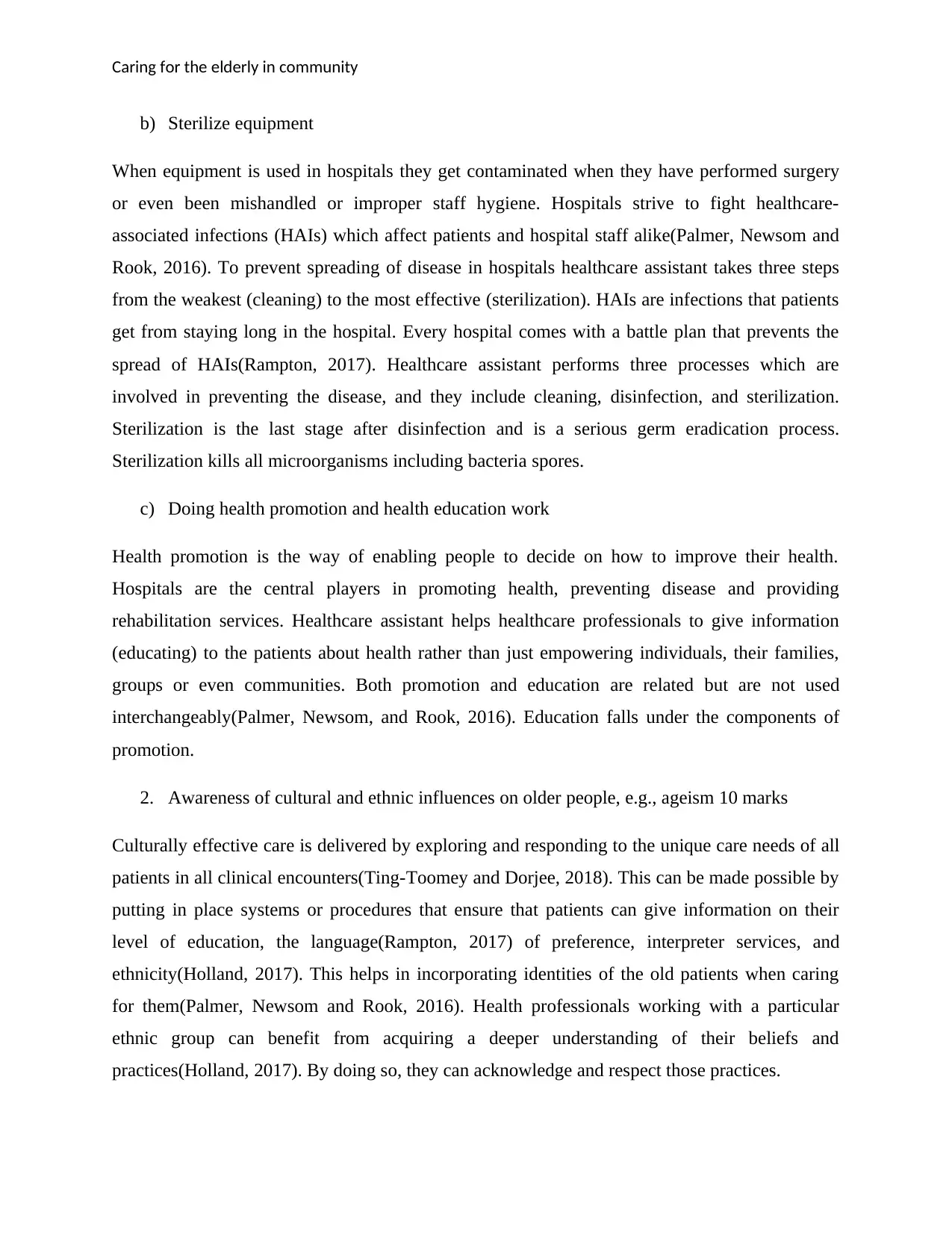
Caring for the elderly in community
b) Sterilize equipment
When equipment is used in hospitals they get contaminated when they have performed surgery
or even been mishandled or improper staff hygiene. Hospitals strive to fight healthcare-
associated infections (HAIs) which affect patients and hospital staff alike(Palmer, Newsom and
Rook, 2016). To prevent spreading of disease in hospitals healthcare assistant takes three steps
from the weakest (cleaning) to the most effective (sterilization). HAIs are infections that patients
get from staying long in the hospital. Every hospital comes with a battle plan that prevents the
spread of HAIs(Rampton, 2017). Healthcare assistant performs three processes which are
involved in preventing the disease, and they include cleaning, disinfection, and sterilization.
Sterilization is the last stage after disinfection and is a serious germ eradication process.
Sterilization kills all microorganisms including bacteria spores.
c) Doing health promotion and health education work
Health promotion is the way of enabling people to decide on how to improve their health.
Hospitals are the central players in promoting health, preventing disease and providing
rehabilitation services. Healthcare assistant helps healthcare professionals to give information
(educating) to the patients about health rather than just empowering individuals, their families,
groups or even communities. Both promotion and education are related but are not used
interchangeably(Palmer, Newsom, and Rook, 2016). Education falls under the components of
promotion.
2. Awareness of cultural and ethnic influences on older people, e.g., ageism 10 marks
Culturally effective care is delivered by exploring and responding to the unique care needs of all
patients in all clinical encounters(Ting-Toomey and Dorjee, 2018). This can be made possible by
putting in place systems or procedures that ensure that patients can give information on their
level of education, the language(Rampton, 2017) of preference, interpreter services, and
ethnicity(Holland, 2017). This helps in incorporating identities of the old patients when caring
for them(Palmer, Newsom and Rook, 2016). Health professionals working with a particular
ethnic group can benefit from acquiring a deeper understanding of their beliefs and
practices(Holland, 2017). By doing so, they can acknowledge and respect those practices.
b) Sterilize equipment
When equipment is used in hospitals they get contaminated when they have performed surgery
or even been mishandled or improper staff hygiene. Hospitals strive to fight healthcare-
associated infections (HAIs) which affect patients and hospital staff alike(Palmer, Newsom and
Rook, 2016). To prevent spreading of disease in hospitals healthcare assistant takes three steps
from the weakest (cleaning) to the most effective (sterilization). HAIs are infections that patients
get from staying long in the hospital. Every hospital comes with a battle plan that prevents the
spread of HAIs(Rampton, 2017). Healthcare assistant performs three processes which are
involved in preventing the disease, and they include cleaning, disinfection, and sterilization.
Sterilization is the last stage after disinfection and is a serious germ eradication process.
Sterilization kills all microorganisms including bacteria spores.
c) Doing health promotion and health education work
Health promotion is the way of enabling people to decide on how to improve their health.
Hospitals are the central players in promoting health, preventing disease and providing
rehabilitation services. Healthcare assistant helps healthcare professionals to give information
(educating) to the patients about health rather than just empowering individuals, their families,
groups or even communities. Both promotion and education are related but are not used
interchangeably(Palmer, Newsom, and Rook, 2016). Education falls under the components of
promotion.
2. Awareness of cultural and ethnic influences on older people, e.g., ageism 10 marks
Culturally effective care is delivered by exploring and responding to the unique care needs of all
patients in all clinical encounters(Ting-Toomey and Dorjee, 2018). This can be made possible by
putting in place systems or procedures that ensure that patients can give information on their
level of education, the language(Rampton, 2017) of preference, interpreter services, and
ethnicity(Holland, 2017). This helps in incorporating identities of the old patients when caring
for them(Palmer, Newsom and Rook, 2016). Health professionals working with a particular
ethnic group can benefit from acquiring a deeper understanding of their beliefs and
practices(Holland, 2017). By doing so, they can acknowledge and respect those practices.
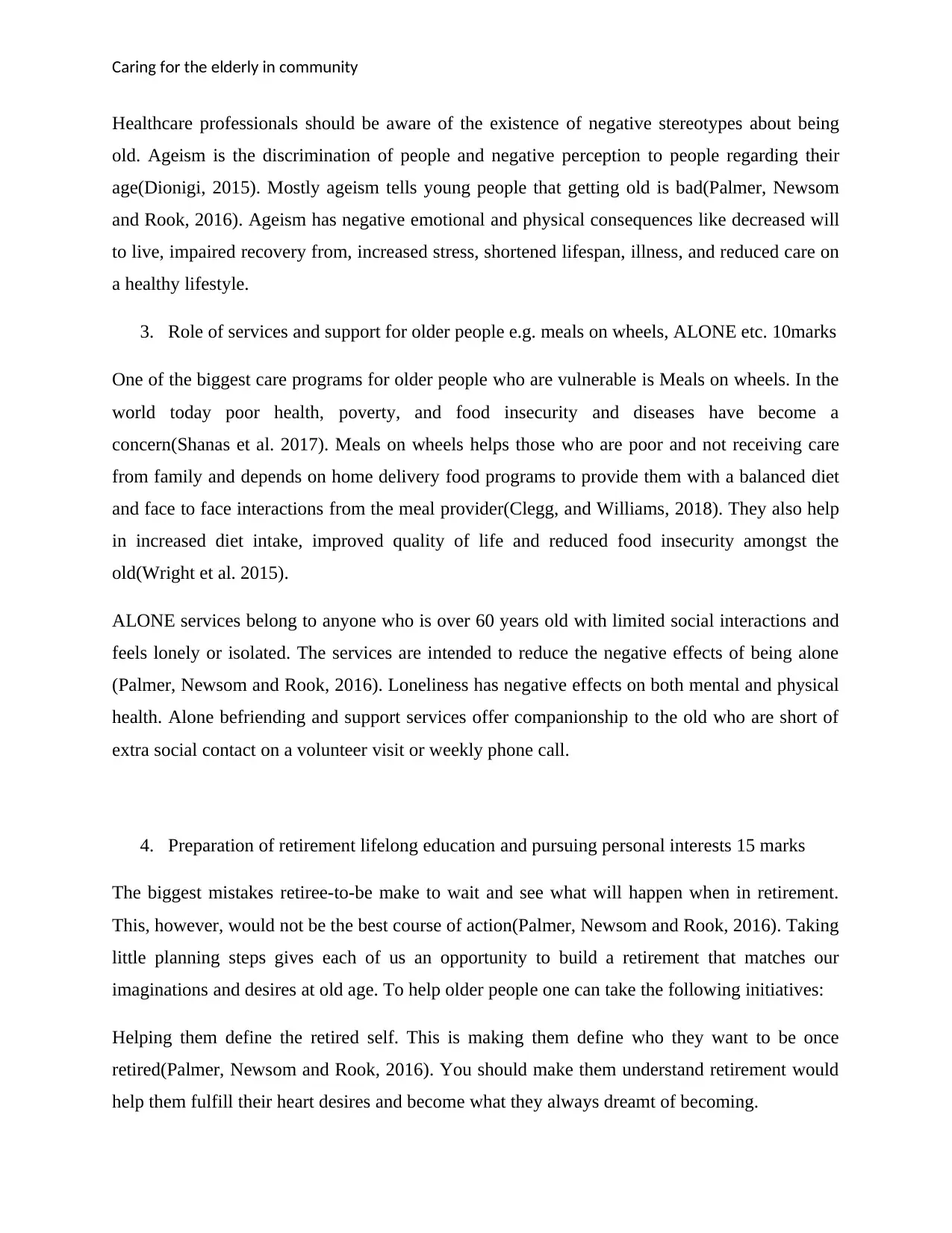
Caring for the elderly in community
Healthcare professionals should be aware of the existence of negative stereotypes about being
old. Ageism is the discrimination of people and negative perception to people regarding their
age(Dionigi, 2015). Mostly ageism tells young people that getting old is bad(Palmer, Newsom
and Rook, 2016). Ageism has negative emotional and physical consequences like decreased will
to live, impaired recovery from, increased stress, shortened lifespan, illness, and reduced care on
a healthy lifestyle.
3. Role of services and support for older people e.g. meals on wheels, ALONE etc. 10marks
One of the biggest care programs for older people who are vulnerable is Meals on wheels. In the
world today poor health, poverty, and food insecurity and diseases have become a
concern(Shanas et al. 2017). Meals on wheels helps those who are poor and not receiving care
from family and depends on home delivery food programs to provide them with a balanced diet
and face to face interactions from the meal provider(Clegg, and Williams, 2018). They also help
in increased diet intake, improved quality of life and reduced food insecurity amongst the
old(Wright et al. 2015).
ALONE services belong to anyone who is over 60 years old with limited social interactions and
feels lonely or isolated. The services are intended to reduce the negative effects of being alone
(Palmer, Newsom and Rook, 2016). Loneliness has negative effects on both mental and physical
health. Alone befriending and support services offer companionship to the old who are short of
extra social contact on a volunteer visit or weekly phone call.
4. Preparation of retirement lifelong education and pursuing personal interests 15 marks
The biggest mistakes retiree-to-be make to wait and see what will happen when in retirement.
This, however, would not be the best course of action(Palmer, Newsom and Rook, 2016). Taking
little planning steps gives each of us an opportunity to build a retirement that matches our
imaginations and desires at old age. To help older people one can take the following initiatives:
Helping them define the retired self. This is making them define who they want to be once
retired(Palmer, Newsom and Rook, 2016). You should make them understand retirement would
help them fulfill their heart desires and become what they always dreamt of becoming.
Healthcare professionals should be aware of the existence of negative stereotypes about being
old. Ageism is the discrimination of people and negative perception to people regarding their
age(Dionigi, 2015). Mostly ageism tells young people that getting old is bad(Palmer, Newsom
and Rook, 2016). Ageism has negative emotional and physical consequences like decreased will
to live, impaired recovery from, increased stress, shortened lifespan, illness, and reduced care on
a healthy lifestyle.
3. Role of services and support for older people e.g. meals on wheels, ALONE etc. 10marks
One of the biggest care programs for older people who are vulnerable is Meals on wheels. In the
world today poor health, poverty, and food insecurity and diseases have become a
concern(Shanas et al. 2017). Meals on wheels helps those who are poor and not receiving care
from family and depends on home delivery food programs to provide them with a balanced diet
and face to face interactions from the meal provider(Clegg, and Williams, 2018). They also help
in increased diet intake, improved quality of life and reduced food insecurity amongst the
old(Wright et al. 2015).
ALONE services belong to anyone who is over 60 years old with limited social interactions and
feels lonely or isolated. The services are intended to reduce the negative effects of being alone
(Palmer, Newsom and Rook, 2016). Loneliness has negative effects on both mental and physical
health. Alone befriending and support services offer companionship to the old who are short of
extra social contact on a volunteer visit or weekly phone call.
4. Preparation of retirement lifelong education and pursuing personal interests 15 marks
The biggest mistakes retiree-to-be make to wait and see what will happen when in retirement.
This, however, would not be the best course of action(Palmer, Newsom and Rook, 2016). Taking
little planning steps gives each of us an opportunity to build a retirement that matches our
imaginations and desires at old age. To help older people one can take the following initiatives:
Helping them define the retired self. This is making them define who they want to be once
retired(Palmer, Newsom and Rook, 2016). You should make them understand retirement would
help them fulfill their heart desires and become what they always dreamt of becoming.
Secure Best Marks with AI Grader
Need help grading? Try our AI Grader for instant feedback on your assignments.
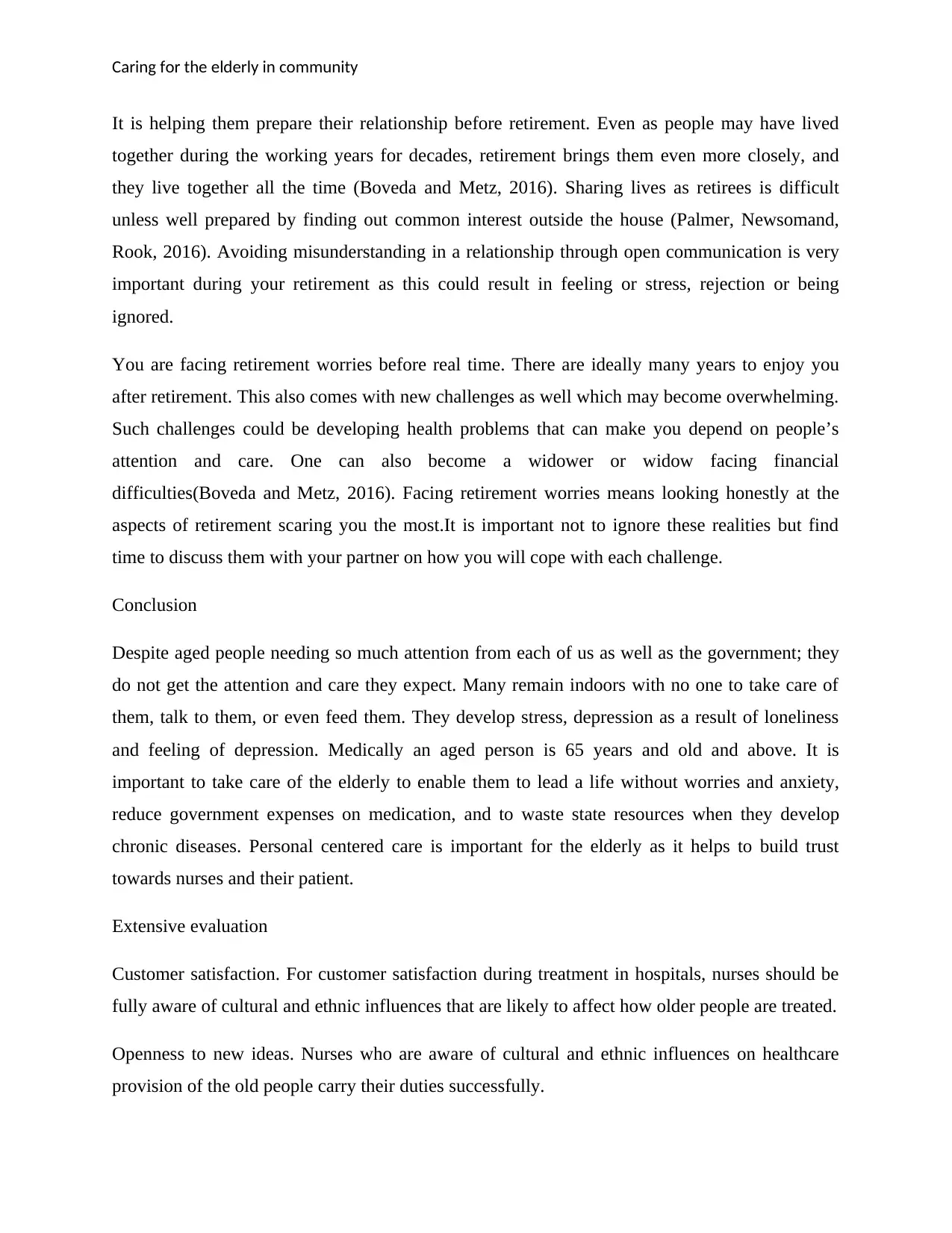
Caring for the elderly in community
It is helping them prepare their relationship before retirement. Even as people may have lived
together during the working years for decades, retirement brings them even more closely, and
they live together all the time (Boveda and Metz, 2016). Sharing lives as retirees is difficult
unless well prepared by finding out common interest outside the house (Palmer, Newsomand,
Rook, 2016). Avoiding misunderstanding in a relationship through open communication is very
important during your retirement as this could result in feeling or stress, rejection or being
ignored.
You are facing retirement worries before real time. There are ideally many years to enjoy you
after retirement. This also comes with new challenges as well which may become overwhelming.
Such challenges could be developing health problems that can make you depend on people’s
attention and care. One can also become a widower or widow facing financial
difficulties(Boveda and Metz, 2016). Facing retirement worries means looking honestly at the
aspects of retirement scaring you the most.It is important not to ignore these realities but find
time to discuss them with your partner on how you will cope with each challenge.
Conclusion
Despite aged people needing so much attention from each of us as well as the government; they
do not get the attention and care they expect. Many remain indoors with no one to take care of
them, talk to them, or even feed them. They develop stress, depression as a result of loneliness
and feeling of depression. Medically an aged person is 65 years and old and above. It is
important to take care of the elderly to enable them to lead a life without worries and anxiety,
reduce government expenses on medication, and to waste state resources when they develop
chronic diseases. Personal centered care is important for the elderly as it helps to build trust
towards nurses and their patient.
Extensive evaluation
Customer satisfaction. For customer satisfaction during treatment in hospitals, nurses should be
fully aware of cultural and ethnic influences that are likely to affect how older people are treated.
Openness to new ideas. Nurses who are aware of cultural and ethnic influences on healthcare
provision of the old people carry their duties successfully.
It is helping them prepare their relationship before retirement. Even as people may have lived
together during the working years for decades, retirement brings them even more closely, and
they live together all the time (Boveda and Metz, 2016). Sharing lives as retirees is difficult
unless well prepared by finding out common interest outside the house (Palmer, Newsomand,
Rook, 2016). Avoiding misunderstanding in a relationship through open communication is very
important during your retirement as this could result in feeling or stress, rejection or being
ignored.
You are facing retirement worries before real time. There are ideally many years to enjoy you
after retirement. This also comes with new challenges as well which may become overwhelming.
Such challenges could be developing health problems that can make you depend on people’s
attention and care. One can also become a widower or widow facing financial
difficulties(Boveda and Metz, 2016). Facing retirement worries means looking honestly at the
aspects of retirement scaring you the most.It is important not to ignore these realities but find
time to discuss them with your partner on how you will cope with each challenge.
Conclusion
Despite aged people needing so much attention from each of us as well as the government; they
do not get the attention and care they expect. Many remain indoors with no one to take care of
them, talk to them, or even feed them. They develop stress, depression as a result of loneliness
and feeling of depression. Medically an aged person is 65 years and old and above. It is
important to take care of the elderly to enable them to lead a life without worries and anxiety,
reduce government expenses on medication, and to waste state resources when they develop
chronic diseases. Personal centered care is important for the elderly as it helps to build trust
towards nurses and their patient.
Extensive evaluation
Customer satisfaction. For customer satisfaction during treatment in hospitals, nurses should be
fully aware of cultural and ethnic influences that are likely to affect how older people are treated.
Openness to new ideas. Nurses who are aware of cultural and ethnic influences on healthcare
provision of the old people carry their duties successfully.
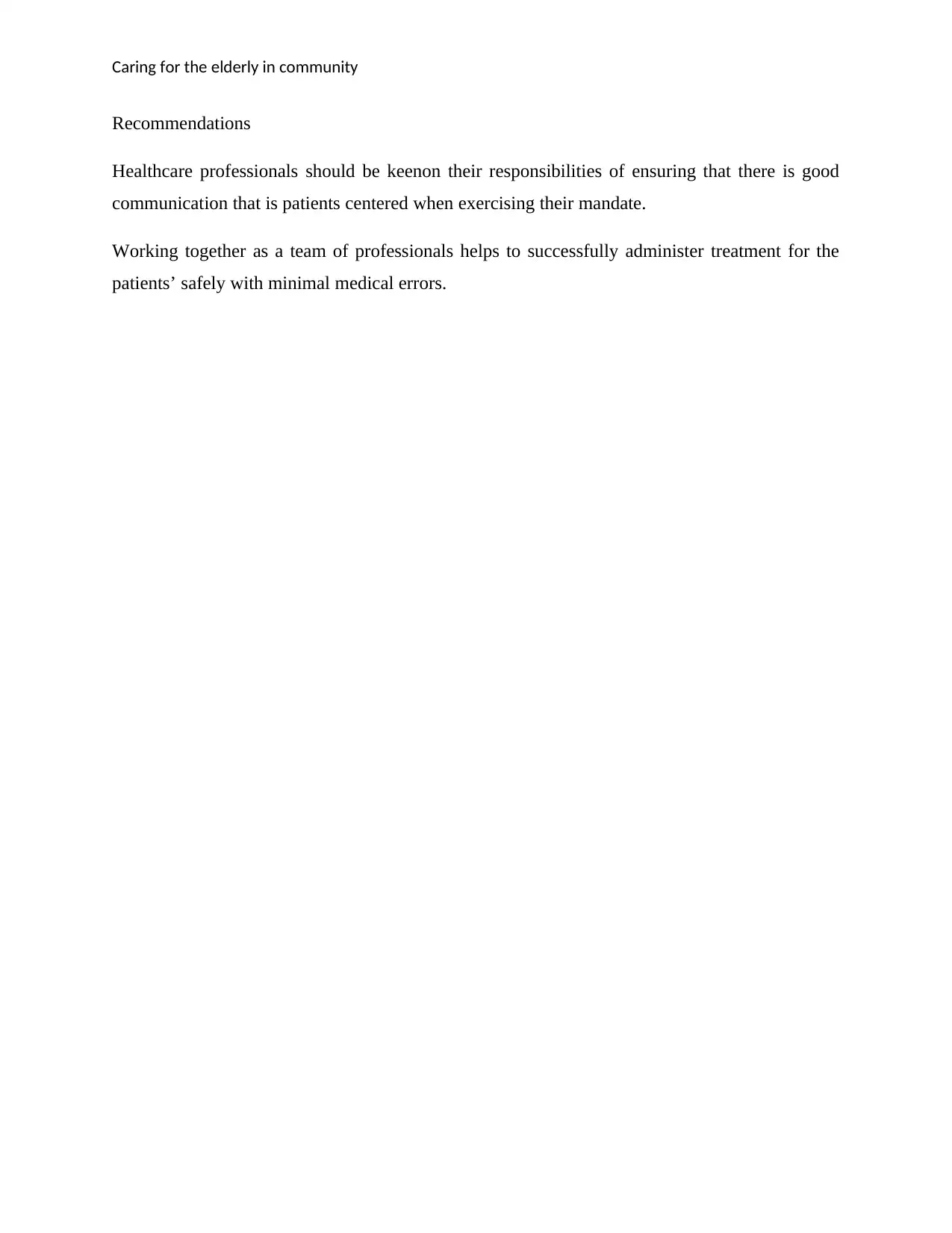
Caring for the elderly in community
Recommendations
Healthcare professionals should be keenon their responsibilities of ensuring that there is good
communication that is patients centered when exercising their mandate.
Working together as a team of professionals helps to successfully administer treatment for the
patients’ safely with minimal medical errors.
Recommendations
Healthcare professionals should be keenon their responsibilities of ensuring that there is good
communication that is patients centered when exercising their mandate.
Working together as a team of professionals helps to successfully administer treatment for the
patients’ safely with minimal medical errors.
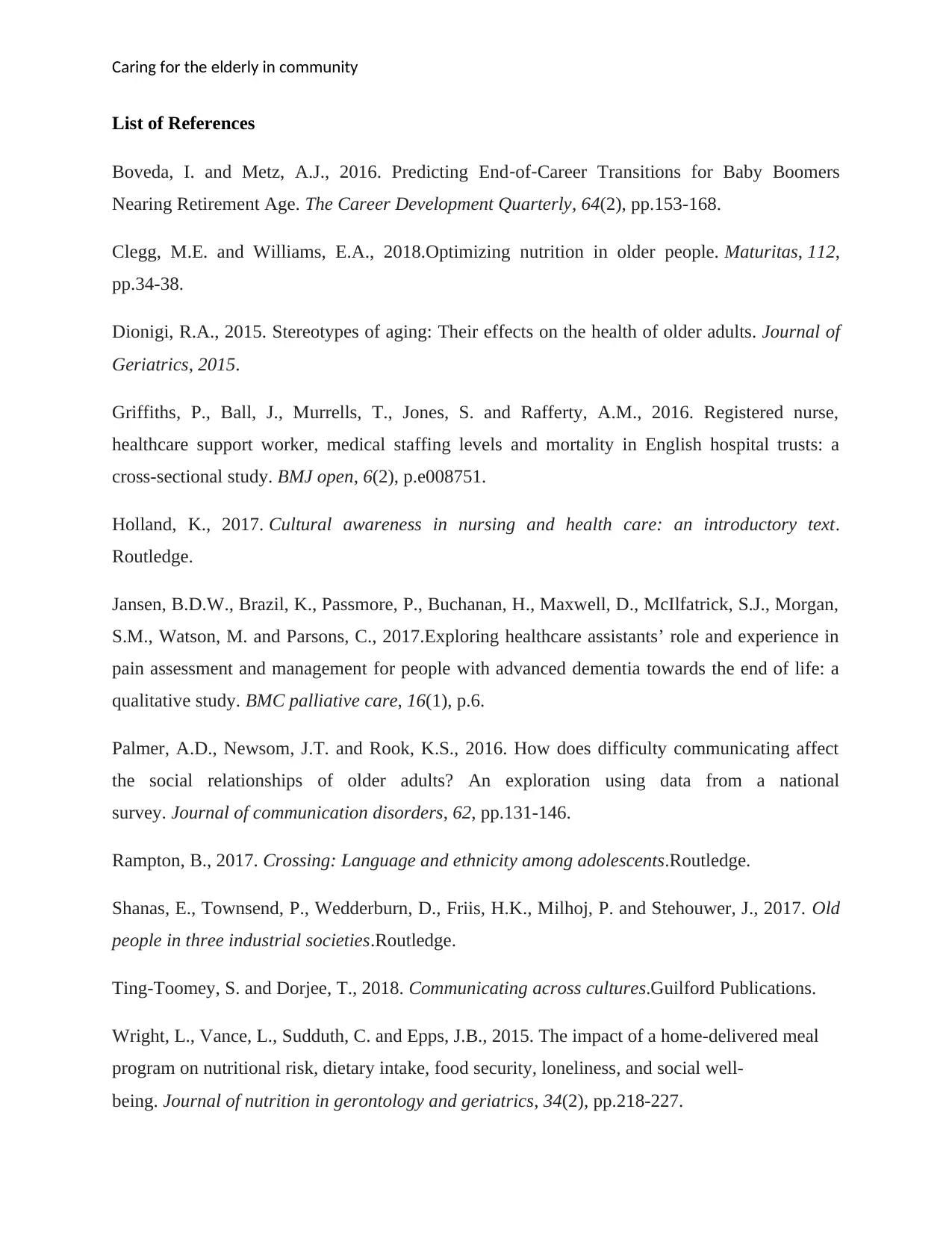
Caring for the elderly in community
List of References
Boveda, I. and Metz, A.J., 2016. Predicting End‐of‐Career Transitions for Baby Boomers
Nearing Retirement Age. The Career Development Quarterly, 64(2), pp.153-168.
Clegg, M.E. and Williams, E.A., 2018.Optimizing nutrition in older people. Maturitas, 112,
pp.34-38.
Dionigi, R.A., 2015. Stereotypes of aging: Their effects on the health of older adults. Journal of
Geriatrics, 2015.
Griffiths, P., Ball, J., Murrells, T., Jones, S. and Rafferty, A.M., 2016. Registered nurse,
healthcare support worker, medical staffing levels and mortality in English hospital trusts: a
cross-sectional study. BMJ open, 6(2), p.e008751.
Holland, K., 2017. Cultural awareness in nursing and health care: an introductory text.
Routledge.
Jansen, B.D.W., Brazil, K., Passmore, P., Buchanan, H., Maxwell, D., McIlfatrick, S.J., Morgan,
S.M., Watson, M. and Parsons, C., 2017.Exploring healthcare assistants’ role and experience in
pain assessment and management for people with advanced dementia towards the end of life: a
qualitative study. BMC palliative care, 16(1), p.6.
Palmer, A.D., Newsom, J.T. and Rook, K.S., 2016. How does difficulty communicating affect
the social relationships of older adults? An exploration using data from a national
survey. Journal of communication disorders, 62, pp.131-146.
Rampton, B., 2017. Crossing: Language and ethnicity among adolescents.Routledge.
Shanas, E., Townsend, P., Wedderburn, D., Friis, H.K., Milhoj, P. and Stehouwer, J., 2017. Old
people in three industrial societies.Routledge.
Ting-Toomey, S. and Dorjee, T., 2018. Communicating across cultures.Guilford Publications.
Wright, L., Vance, L., Sudduth, C. and Epps, J.B., 2015. The impact of a home-delivered meal
program on nutritional risk, dietary intake, food security, loneliness, and social well-
being. Journal of nutrition in gerontology and geriatrics, 34(2), pp.218-227.
List of References
Boveda, I. and Metz, A.J., 2016. Predicting End‐of‐Career Transitions for Baby Boomers
Nearing Retirement Age. The Career Development Quarterly, 64(2), pp.153-168.
Clegg, M.E. and Williams, E.A., 2018.Optimizing nutrition in older people. Maturitas, 112,
pp.34-38.
Dionigi, R.A., 2015. Stereotypes of aging: Their effects on the health of older adults. Journal of
Geriatrics, 2015.
Griffiths, P., Ball, J., Murrells, T., Jones, S. and Rafferty, A.M., 2016. Registered nurse,
healthcare support worker, medical staffing levels and mortality in English hospital trusts: a
cross-sectional study. BMJ open, 6(2), p.e008751.
Holland, K., 2017. Cultural awareness in nursing and health care: an introductory text.
Routledge.
Jansen, B.D.W., Brazil, K., Passmore, P., Buchanan, H., Maxwell, D., McIlfatrick, S.J., Morgan,
S.M., Watson, M. and Parsons, C., 2017.Exploring healthcare assistants’ role and experience in
pain assessment and management for people with advanced dementia towards the end of life: a
qualitative study. BMC palliative care, 16(1), p.6.
Palmer, A.D., Newsom, J.T. and Rook, K.S., 2016. How does difficulty communicating affect
the social relationships of older adults? An exploration using data from a national
survey. Journal of communication disorders, 62, pp.131-146.
Rampton, B., 2017. Crossing: Language and ethnicity among adolescents.Routledge.
Shanas, E., Townsend, P., Wedderburn, D., Friis, H.K., Milhoj, P. and Stehouwer, J., 2017. Old
people in three industrial societies.Routledge.
Ting-Toomey, S. and Dorjee, T., 2018. Communicating across cultures.Guilford Publications.
Wright, L., Vance, L., Sudduth, C. and Epps, J.B., 2015. The impact of a home-delivered meal
program on nutritional risk, dietary intake, food security, loneliness, and social well-
being. Journal of nutrition in gerontology and geriatrics, 34(2), pp.218-227.
1 out of 7
Related Documents
Your All-in-One AI-Powered Toolkit for Academic Success.
+13062052269
info@desklib.com
Available 24*7 on WhatsApp / Email
![[object Object]](/_next/static/media/star-bottom.7253800d.svg)
Unlock your academic potential
© 2024 | Zucol Services PVT LTD | All rights reserved.





